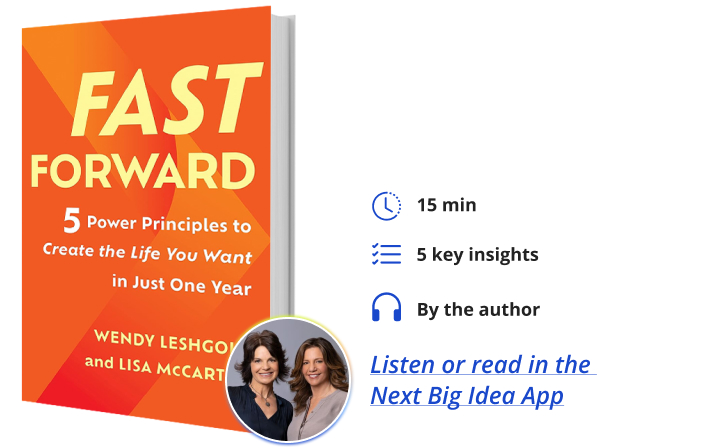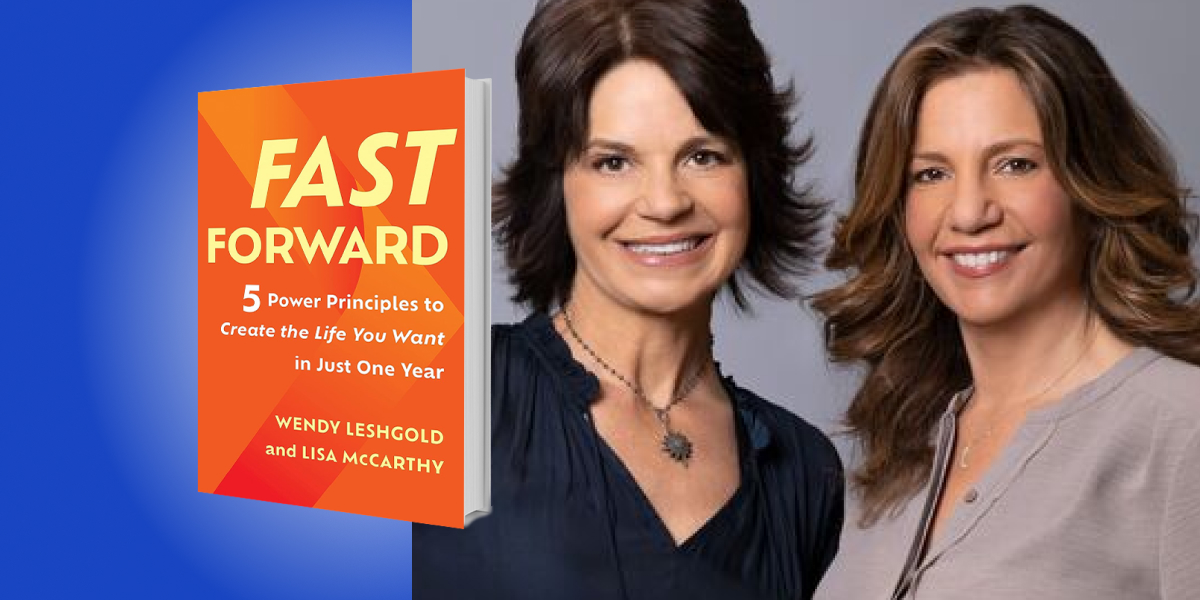Wendy Leshgold is the co-founder of the Fast Forward Group, a training and executive coaching company. Previously, she spent more than a decade in advertising, leading teams at Ogilvy & Mather, BBDO, and Deutsch, where she worked with brands including Apple, Kodak, IBM, Bank of America, and Mitsubishi. Wendy is also a highly active board member of California Environmental Voters.
Lisa McCarthy is the CEO and co-founder of The Fast Forward Group. She has also spent 25 years at prominent media companies Univision, Viacom, and CBS, leading sales organizations that were responsible for billions in revenue. Recognized as a people-first leader and change agent, Lisa was named a “Woman to Watch” by Advertising Age and was included in Crain’s New York “Business 40 Under 40.”
Below, co-authors Wendy and Lisa share 5 key insights from their new book, Fast Forward: 5 Power Principles to Create the Life You Want in Just One Year. Listen to the audio version—read by Wendy—in the Next Big Idea App.

1. To create the life you want, be highly specific about what it looks like.
Declare a bold vision. It’s an essential starting point. How can you create the life you want if you don’t know what it looks like? We use a one-year timeframe because it allows people to paint a detailed picture, while also imagining a future reality that’s substantially different from the present. It’s logically engaging and emotionally inspiring. Being clear and bold also helps you communicate your vision to others.
Here’s the exercise we use: Fast forward one year in the future. Imagine yourself in that moment and answer these questions: What does extraordinary success look like in your whole life? What have you achieved professionally and personally? What do your important relationships look like? What are you known for? How have you grown?
As you write your answers, be vivid, specific, and bold. Describe the details of your outcomes, what’s different, and how you feel. Don’t let limiting beliefs about what’s possible hold you back.
Once you’ve written the story of what will make this year your best year, take a leap and share it with the important people in your life and anybody who can help you achieve it. It can feel risky and uncomfortable because you’re putting yourself on the hook, but you’ll need support to achieve your bold goals. You’ll need help staying motivated, committed, and accountable.
2. Take control of the stories you tell yourself.
Is there a situation or relationship in your life that’s causing you stress or sapping your energy? Do you have an inner critic that’s always looming, ready to pounce? Behind that nagging issue is a negative, disempowering story that will keep you from the life you want: Like “I don’t have what it takes to succeed here.” Or “My sister and I aren’t close.” Or “This job is leading me nowhere.”
To help you understand and navigate the world, your brain collects information, uses it to create stories, and then keeps proving them by collecting “evidence.” The brain relates to these stories, your perspective, like they’re the truth. But your stories are not fact, and you’re not stuck with them. You have 100 percent choice in your perspective. When you make a different choice, you’re empowered to create different outcomes.
“You have 100 percent choice in your perspective.”
One of our clients, Andy, went home most nights fuming about his colleague Maria. Worse, he complained about her to his team, creating a toxic environment. The story he told us was so disempowering: “Maria is egotistical and difficult. She never listens and refuses to collaborate. We can’t work together.”
We helped Andy take three critical steps: First, he acknowledged the cost of his story. Every negative story comes with a cost. His was creating toxicity, stress, and repercussions in his career. Second, we had him list the objective, undeniable facts of the situation—no opinions allowed. He and Maria had worked together for five years, both rising into their leadership positions, and they now reported to the same person. Their departments worked closely together. Third, we brainstormed new, more empowering perspectives Andy could take on instead, like “I can learn from Maria; she has experience that I don’t.” The perspective he finally chose was “Maria is essential to my success; we have the same goals.”
With that new lens on the relationship, Andy asked, “If that’s true, what would I do differently?” First, he invited her to attend his monthly team meeting to learn about their projects. Then, he invited her to lunch to share aspects of his vision. Step by step, he used his perspective to shift his thinking and behavior, which created opportunities for Maria to show up differently, too. Three months later, their relationship looked entirely different, Andy was happier, and his team was more successful.
3. Start taking ground immediately.
Often, we watch somebody read their vision aloud with excitement. Then their face falls, resignation creeps in, and they say, “I don’t have the time or energy to make this happen.” Here’s the reality we always share: You have enough time and energy for the things that matter most to you. In your life, you’re spending that time and energy on things that aren’t important or that aren’t in service of what you want or your own success or happiness. When you start saying yes to the outcomes or commitments that do matter, you’ll feel motivated, energized, and confident in your ability to succeed.
If your days feel out of your control and your goals feel out of reach, we suggest giving yourself the gift of a 90-day action plan that actually generates motivation and momentum. Start with the finish. Identify two or three outcomes or goals that you’ll say yes to for the next 90 days. Then, identify the next obvious action. What could you do today or this week to make progress? Be clear and specific, so that you know exactly what you’re supposed to do.
We had a client, Laura, who carried a lot of guilt about not spending enough time with her family. In her vision, she wrote, “I’m placing importance on family time by having dinner with my family three nights a week and not working on Sundays.” But it felt unrealistic. Her days were filled with meetings and requests for help, which meant she had to spend hours at night and on weekends getting caught up on her own important work.
“When you start saying yes to the outcomes or commitments that do matter, you’ll feel motivated, energized, and confident in your ability to succeed.”
We asked her to think about what she could do immediately to be less reactive to requests and more intentional with her time and focus. In her action plan, she wrote: “Review my calendar for the next two weeks. Reach out to meeting hosts to find out if I actually need to attend.” Amazingly, almost half said no. They were asking because they thought she wanted to be there.
After a month of working on this habit, she had opened up five hours in her schedule every week. That success gave her the momentum to take other action, like developing language for saying no more often. By the end of 90 days, her vision for quality family time that had seemed out of reach was her new reality.
4. Communicate in a way that drives action and results.
Brad was in the middle of a career transition. He had an incredible network, and I helped him develop an action plan for reaching out to people and asking for recommendations, for leads on open positions, or for introductions. When we met a month later and I asked how it was going, he said, “Terribly. Nothing’s happening.”
That wasn’t what we had expected, so I asked him to walk me through a call he had made that week. The former colleague was receptive and friendly, and she showed interest in Brad’s new career goals. “We caught up on family stuff, and then we said goodbye.”
Can you see the problem? Brad never asked her to help him. He had never made a specific request.
An amazing thing happens when you ask for what you want—often, you get it! But that’s not how most of us communicate. We don’t use the language of action. Language of action is designed to help move the ball down the field. It’s direct, specific, and compelling. Examples include making recommendations or requests, taking a stand, asking for help, and getting aligned on who is doing what and by when.
Why don’t we communicate this way? Because it feels risky. We’re worried we’ll be shut down. We’re worried about potential backlash. We don’t want to seem like we’re coming on too strong or being too needy.
“Take the time to be intentional and make every conversation count.”
To become a more confident communicator, we recommend taking the time to effectively plan your most important conversations. First, and most important, with your audience in mind, what is the desired outcome? At the end of the conversation, what will your audience believe, feel, and do? This step alone can dramatically change the effectiveness of your meetings. Next, what specific recommendations or requests will you make and why? What questions will you ask? What objections or concerns might come up, and how will you handle them? And finally, how will you close or end the conversation in a way that leaves everybody clear about the action to take next?
If you want to bring more people on board with your vision and goals, take the time to be intentional and make every conversation count.
5. Stop talking and get curious.
Our default mode in life is to listen without hearing, without curiosity. Most of the time, most of us listen through a filter—to reply or find opportunities to be smart or right, to relate what’s being said back to our own interests or experience, to solve or fix a problem, or to confirm our assumptions.
Because of this, we miss out on three big opportunities. First, we miss the opportunity to build connection and trust that deepens relationships. Second, we miss the opportunity to learn and gather good ideas that could help us make progress faster. We aren’t present or engaged, so we aren’t processing what the other person is sharing. Third, we miss the opportunity help other people learn to solve their own problems—and grow!
Listening well is the foundation of good coaching. When you let people talk about their challenges and ask a few open-ended questions to prompt them to go deeper, you’ll be amazed by the brilliant, creative, resourceful solutions they come up with. Even better, they’ll own the idea, which means they’re far more likely to follow through.
When more people in your life are solving their own problems, with some targeted coaching conversations with you, you’ll be freed up to focus on your own goals and plans.
To improve your listening skills, practice the essentials. Slow everything down and be fully present. Get rid of distractions and take some deep, slow breaths to calm your mind. Show your listening with open body language. Most important, look at the person. Don’t interrupt or take the person on a tangent. If there’s a lull, prompt them with open-ended questions, like “How would you like it to look?” or even “What did you do next?” If you check out and lose focus, take notice and check back in.
Good listening takes discipline, self-restraint, and practice, but it’s so worth it.
We all have the power to fuel our own happiness. Our five principles shift your relationship with that power. They help you get clear, be bold, and take action. I hope you see opportunities to practice them in your life starting now.
To listen to the audio version read by co-author Wendy Leshgold, download the Next Big Idea App today:































